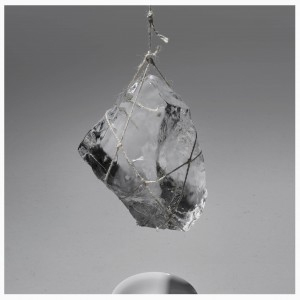The Japanese sound artist's second album is the result of a ten-year investigation on the sound properties of water, in line with her previous LP in 2009. Based on the use of waterbowls—porcelain bowls filled with water and amplified via hydrophones—her musical practice is now enriched with experiments with the
environment and hydrophonic feedback.
Musique Hydromantique is the second solo album by Tomoko Sauvage archiving many years of her performance-based practice on the waterbowls—the natural synthesizer of her invention, composed with porcelain bowls filled with water and amplified via hydrophones (underwater microphones). While her first album Ombrophilia (released on and/OAR in 2009) was studio-recorded /composed work, Musique Hydromantique is about experimentation and improvisation with the environment—acoustics affected by the architecture, temperature, humidity and the human presence.
For more than ten years, Sauvage has been investigating the sound and visual properties of water in different states, as well as those of ceramics, combined with electronics. Water drops, waves and bubbles are some of the elements she has been playing with to generate the fluid timbre. Since around 2010, hydrophonic feedback has been an obsession for the musician—an acoustic phenomenon that requires fine tuning depending on the amount of water, a subtle volume control and interaction with the acoustic space.
Calligraphy was recorded in a genuine echo chamber, with about 10 second reverbs, situated in a former textile factory. Like an endless exercise to draw perfect curves and forms floating in the air, the subaquatic feedback frequencies are pitch-bended with the mass of water sculpted by a hand changing its quantity. Fortune Biscuit is about the singing bubbles emitted from the pieces of “biscuit” (porous terra-cotta). Depending on the texture of the surface, each biscuit makes different sound : insect and animal voices in a forest, motors, crying babies changing pitches and rhythms while absorbing the water… Clepsydra (meaning water clock) features Sauvage's classical technique, a random percussion with dripping water. She tunes the waterbowls by adding and removing water, making flowing glissando, to find the balance point in ever-changing tonalities.
Just as the flow of water is subject to a number of variables such as temperature and pressure, water clocks mark a time that is shifting and relative. However, slowness dominates throughout the album as a result of favoring the full resonance of the instrument, leading to a path to experiencing timelessness.
Hydromancy is a method of divination by means of water. Unpredictable bubbles and water ripples become oracles. Evaporation and acoustic space constantly play a chance operation. Through primordial materials and ritualistic yet playful gestures, Musique Hydromantique questions contemporary divination.
All the tracks are live-recorded without electronic effects or editing. They were recorded during the night or very early in the morning and the whole album is to be listened to during that period of a day.
Tomoko Sauvage, Japanese musician/sound artist based in Paris, has been working on waterbowls, porcelain bowls of different sizes, filled with water and amplified with hydrophones (under-water microphones). She plays with different forms of water—drops, waves and bubbles resonating in the bowls as well as audio feedback creating waving drones and natural overtones. Her work is about the delicate balance between controlled and uncontrolled with random percussion of droplets, acoustic characteristics of the space and the fragile tonality created with the fluid materials constantly evaporating and moving.
Sauvage has been giving performances, exhibitions and workshops in Europe, US, Canada and Japan, often in solo but also in collaboration with musicians and choreographers. Her works have been released by and/OAR (US),
Aposiopèse (BE), dokidoki editions (FR),
Shelter Press (FR)...
In 2011, a new set of porcelain bowls was created during her residency at La Pommerie (FR) in collaboration with Ceramic Research Center in Limoges (CRAFT).
Mastered by Rashad Becker at D+M.
published in November 2017
3 tracks (10'49 / 08'37 / 20'34)
sold out

